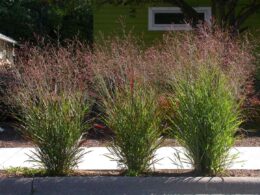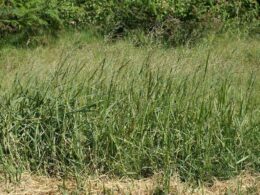Barnyard Grass Appearance
Echinochloa crus-galli, (common name barnyard grass), is a common weed that can be found in agricultural fields, gardens, and lawns. It is a summer annual Panicum grass that typically grows to a height of 80-150 cm (31-59 inches). The leaves are green to blue-green in color and the stems are erect with nodes that are close together. The inflorescence is a panicle with spikelets, there is no ligule and the sheath is smooth. The grain is similar to millet, oval and usually measures 1 mm in length. The flowers grow in small but showy clusters. The root system is shallow and fibrous.
Barnyard Grass Habitat and Distribution
Barnyard grass is a fast-growing perennial plant native to Asia and Africa. This robust grass thrives in wet environments with poor soil quality and is highly adaptable to a wide range of climates. It is typically found growing along riverbanks and ponds, in ditches, wetland areas, in fields, meadows and along railway roads. In the United States, it is considered a weed plant, and it was first spotted in the area of the Great Lakes in the 1840s.
Barnyard Grass Propagation
Barnyard grass typically blooms in late summer or early fall. Each plant can produce up to 40,000 seeds, which are dispersed by wind, water and animals. When they do germinate, the seedlings will emerge from the soil and begin to grow into new plants.
The Negative Effect of Echinochloa Crus-Galli Weed
Barnyard grass is a highly invasive plant species that can have negative effects on both the environment and human health. It is extremely difficult to control once it has established itself, as it produces high quantities of seeds that are easily dispersed by animals and wind. This weed can also reduce crop yields, as it competes with crops for resources such as sunlight and water. Barnyard grass can also serve as a host for crop pests and diseases. In addition, barnyard grass is known to harbor harmful toxins that can potentially contaminate food supplies.
Are There Any Benefits of Barnyard Grass?
Although barnyard grass is considered a weed by most farmers and gardeners, this hardy plant actually has several uses. For example, barnyard grass can be used as animal feed. This grass makes a fairly good food source for cows, horses, and other grazing animals. In fact, barnyard grass is often used as livestock feed in areas where other food sources are scarce. It can also provide habitat to other animals. While it may not be the most desirable plant, barnyard grass does have some benefits.
How to Control Barnyard Grass From Spreading?
One of the best ways to control barnyard grass is to prevent it from spreading in the first place. This can be done by removing the plant before it goes to seed, and by keeping your gardening area free of debris where the seeds can hide. If you already have a problem with barnyard grass, you’ll need to be diligent in your removal efforts.
Chemical Control
Chemical control is often the only effective method of managing this weed. Unfortunately, barnyard grass is highly resistant to many herbicides, making control difficult. One approach that has shown some success is to use a combination of herbicides with different modes of action. This approach increased the chance of causing injury to the weed while minimizing the risk of developing resistant populations.
Cultural Control
Cultural practices such as crop rotation can help to reduce the number of barnyard grass plants that are able to mature and produce seeds. By using a combination of chemical and cultural controls, farmers can more effectively manage this difficult weed.
Biological Control
Biological control is the intentional use of living organisms to manage pests. It is an important pest management tool that can be used to reduce the use of harmful chemicals. It is difficult to control with herbicides, and it can quickly become resistant to herbicide treatments.
However, there are several potential biological control agents that could be used against barnyard grass, including the rhizobacteria. This organism has the potential to cause significant damage to barnyard grass populations. However, there is no biological method used in the US at the moment.
Herbicide Resistance
The most common type of resistance is multiple resistance, which means that the weed is resistant to more than one herbicide class. This makes Barnyard grass difficult to control, and it can quickly take over a field if left unchecked. It has evolved resistance to several herbicides, including glyphosate, glufosinate, and paraquat. Barnyard grass has a high rate of seed production, which contributes to its spread and persistence in agricultural areas. In order to control barnyard grass populations, farmers need to use an integrated approach.



















